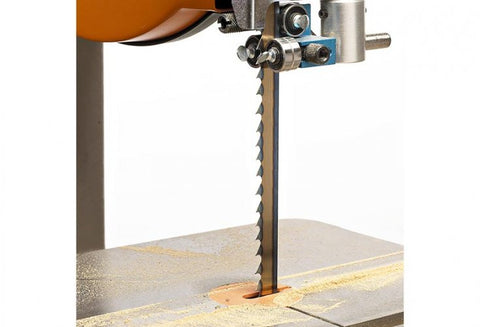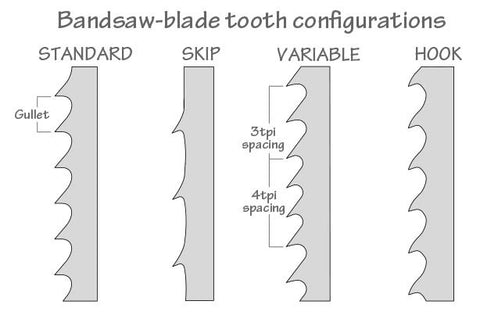How to Choose Bandsaw Blades
Posted by FeiLi on
Make your bandsaw perform like a champ by using the correct blade for each task.

A bandsaw will make many cuts with precision and speed—when equipped with the right blade for the application. But which blade for which task? Before we answer, you need to know how different attributes of a bandsaw blade affect the cut.

Bandsaw blades differ in thickness, width, length, and tooth configuration. Length varies by machine, but the size of your saw's wheels typically determines thickness and width: Smaller machines (9–12" wheels) need thinner blades to prevent breaking the welds. They also accept only narrow blades, often 1/2 " or less. Larger saws usually can handle thicker and wider blades with no issues.
Blades come primarily in the four tooth configurations shown above. And the number of teeth per inch (tpi) matters as well, because larger gullets (the space between teeth) allow for better debris removal; but more closely spaced teeth deliver a smoother cut. Choosing a blade's tooth count and pattern depends on the type of cut and the material you're cutting.
Here's a quick rundown to cover most tasks:
- For cutting tight curves (less than 5/8 " radius) and delicate, thin materials, use a 1/8 " or 3/16 " 10–14-tpi standard-tooth blade.
- To cut curves greater than 5/8 " radius, or when cut quality matters more than speed, use a 1/4 " 6-tpi standard- or skip-tooth blade.
- For general ripping and crosscutting, use a1/2 " 3-tpi standard- or hook-tooth blade.
- For resawing, use the widest 3-tpi skip- or variable-tooth blade your saw accepts. Typically, the wider the blade, the straighter it cuts.
Cutting green (undried) wood requires the widest 2–3-tpi skip-tooth blade your saw accepts.
Dense, abrasive exotic wood species cut best with a carbide-tooth blade. It will stay sharp longer than a steel or bi-metal blade.
Bandsaw blades have a set to their teeth (tips alternately pointing left and right) to allow clearance for the blade body rather than it rubbing the wood, creating friction.
Yes, you can make most cuts with one blade Every time you change from one bandsaw blade width to another, you have to reset the saw's tracking, tension, and blade guides. That process can take 15–30 minutes, depending on your saw. So we understand that you might not want to do that very often. It's the same reason a lot of people use a 40- or 50-tooth combo blade for all cuts on their tablesaw, or the same speed setting for all bits on their drill press. We get it, change is hard.
So, is there a combo-blade equivalent for bandsaws? We say "yes." (Purists, shudder now!) A 3/8 " 4-tpi standard-tooth blade will cut all but the tightest curves, while also ripping, crosscutting, and resawing respectably.
Share this post
- Tags: choose guide
